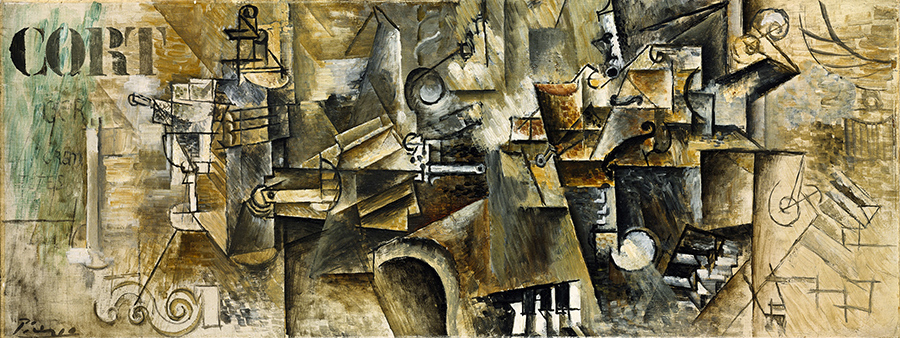The inverted cone, the place of memory-consciousness
During his analytical period, Picasso's painting was esentially the place of memory-consciousness. As the culmination of this period, in his Still Life on a Piano (1911, Heinz Berggruen Collection, Geneva) the artist introduced the image that encapsulated the central thesis in Matter and Memory: the inverted cone.
The image of the inverted cone is the time image and, as such, it occupies a central position. It is the “seed crystal” that makes the immense crystallizable universe spring to life. Capturing this seminal power of the sign in the art of Picasso, Maurice Raynal referred to a so-called “crystal cubism” in 1918.
Aside from its quantitative or spatial expansion, this still life offers qualitative, psychological richness. The figures are no longer juxtaposed, but instead superimposed and interchangeable due to their transparency. As in consciousness or in memory. They are charged with thousands of emotions, sensations, and feelings. Each one is unique in its emergence within the order of the visible: to encompass all their original complexity, one has to relive their own lives, inhabit their own consciousness, delve into the flow of their impersonal memory. The image is generated backwards, advancing towards the viewer, just as a recollection is refreshed in perception (the “future recollection”): Instead of using a foreground from which, by means of perspective, one creates the illusion of a fictitious depth, the painter starts from a background of his own making and imagining. From there, he sets forth a formal schema of sorts in which the position of each object is clearly exposed in relation to the established background and in relation to the other objects.[1] The trompe-l’œil is replaced by a trompe-l’esprit, a device that fools the mind. Rather than expressing feelings, Art tends to impress them upon us; all it does is suggest, and once it has found the most efficient means for doing so, it deliberately releases itself from imitating nature. Like art, nature proceeds by suggestion, but cannot rely upon rhythm.
By introducing letters that refer to music into the dialetics of painting for the first time (the letters CORT, for the piano maker CORTES, fragmented like the image), Picasso recalls the musical metaphor that Bergson uses to illustrate the concept of duration. In Time and Memory, Bergson presents melody as an image of duration and integrates rhythm and measure, with rythmic periodicity allowing for the intuition of duration. As in a melody, everything is contained within the potential for amplification of the ensemble conveyed through the seminal image of the inverted cone. In a genius of rhythm such as Picasso, duration is not set, but rather contributes to the visual world by becoming intuitive. Everything is natural, because the rhythm of the painting is the deconstruction of a construction. In other words, he uses classic writing processes, but uses them as a fulcrum for the imagination and not as a fulcrum for formalization. In Picasso, painting is totally intuitive, as what we feel when we look at it pushes us intuitively to project ourselves into our imagination. Yet, as in Bergson, nothing is set in stone, because all the elements of each note are constantly moving and interconnected. Picasso creates musical signs that all contribute to the unfolding of the imagination while constructing them in an cohesive manner. In other words, each one of the signs provides the image with a key element of the pictural melody, which does not access its visual identity, does not find its image until the visual assemblage has been completed. Thus, Picasso's painting projects us intuitively into our imagination which, due to the diversity of musical feelings, shows us an ever-changing scene.
At certain moments, reality is within our grasp; at others, it moves away. The tide rises and falls, but the sea is always there... Duration? Art!
[1] Daniel-Henri Kahnweiler, Confessions esthétiques, Paris, Hermann, 1963, pp. 31-32.





 Summary
Summary